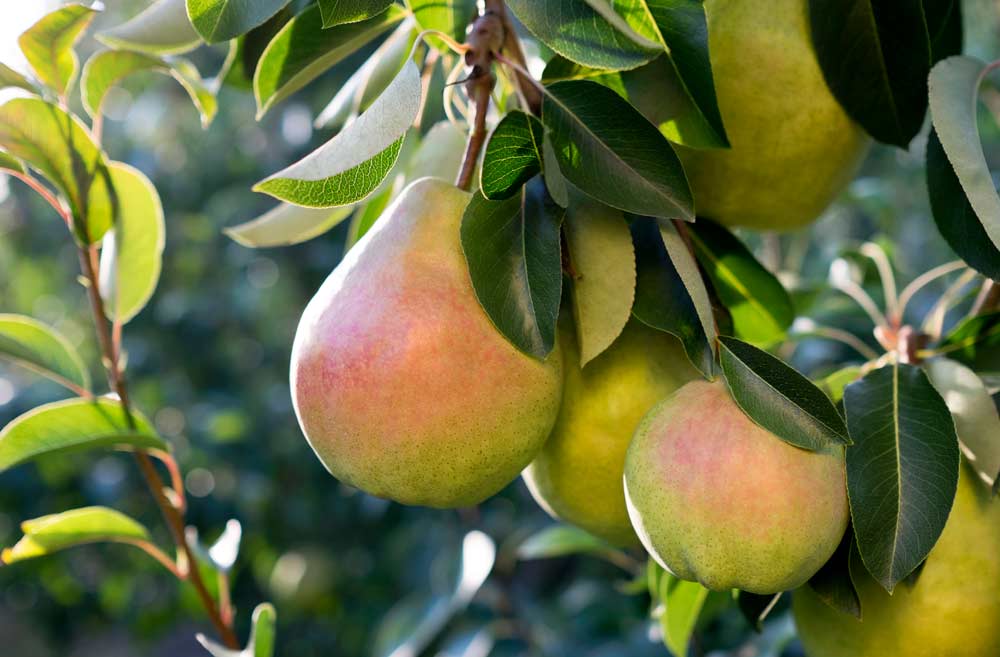
Growers hope Cold Snap pears, shown here in an Ontario orchard in 2016, can restart the Canadian pear industry thanks to their fire blight tolerance and high-density production. (Courtesy Vineland Growers Cooperative)
A decade after a processing plant closed and persistent fire blight problems pushed many Ontario growers out of the pear business, there’s a new excitement about pears in Canada.
The reason: a handful of new varieties that offer fire blight resistance, cold hardiness and high-density production are re-energizing the industry.
Last winter, 20,000 cases of Cold Snap pears were sold to Ontario retailers, said Matt Ecker, sales and business development manager for the Vineland Growers Cooperative, which has the exclusive rights to grow and market the pear in Canada.
Over 80,000 trees have been planted in Ontario and Nova Scotia by about 25 growers, he said.
“It’s was a great opportunity for us to showcase a Canadian grown pear. We marketed it from the last week of November through the start of February, when we ran out,” Ecker said. “It’s a great tasting pear. It’s definitely kick-started our pear industry back here in Ontario.”
Cold Snap
Cold Snap is the marketing program for Harovin Sundown, a pear nearly 40 years in development by now-defunct Harrow breeding program at the Agriculture and Agri-Food Canada’s research station in Ontario.
In 2010, the Vineland Innovation and Research Centre — a nonprofit organization aimed at bringing horticultural innovation to Canadian farmers — assumed the license for Harovin Sundown and began the process of commercializing it, said Michael Kauzlaric, the facility’s technology scout and director of grower outreach.
The center also inherited several other promising pears from the breeding program, and two are being released to growers: HW 623 and HW 624.
Kauzlaric said they are hoping to build on the success of Cold Snap by offering cultivars that have wider harvest windows, enabling growers to extend their season, and that provide exciting new varieties to consumers.
All three new pears have good fire blight tolerance and are well-suited to cold Canadian winters, Kauzlaric said. And they are well suited to producing high yields of large fruit in high-density plantings.
That was the key to enticing growers to give the new pears a chance, Ecker said.
“With new planting practices, such as high-density systems, now with these new fire blight tolerant varieties we can improve production,” Ecker said. “It’s a huge plus for our guys having these large pears that require less labor for thinning.”
The Harovin Sundown pears are propagated on Old Home by Farmingdale 87 — a productive and precocious rootstock that also offers fire blight resistance.
Many growers planted it in tall spindle systems like apples, and some are using bi-axis trees to control the tree’s vigor in the absence of a dwarfing rootstock.
The large pears with a yellow background and a red blush ripen in October. Growers are getting more color on the pears produced in the high-density systems, Ecker said.
The Cold Snap name was chosen to emphasize the pear’s market niche as a winter fruit, Kauzlaric said.
“It doesn’t eat great off the tree, it needs to sit in storage,” he said. That creates the opportunity to extend the pear season into the winter months, while most Ontario pears go to market in the fall, he said. The research facility’s consumer insight group helped develop that branding, he added.
The Vineland Growers Cooperative expects to see production increase about 30 percent a year for the next several years as more orchards come into full production. And as these new varieties prove themselves, Ecker expects to see them replace older Bartlett and Bosc orchards.
“These new Harrow varieties are giving our growers hope again,” he said. “The key for our growers here is that they like to diversify their risk, and pears are a good opportunity to expand our offerings.”
And two more
The newest pears, known as HW 623 and HW 624, eat well right off the tree, Kauzlaric said. He described 623 as a Bosc-shaped pear with a long neck and a little bit of blush that resists russetting and has a “buttery” taste. It’s a medium to large sized fruit that is ready to harvest about two weeks after Bartlett.
Vineland Growers Co-op has also licensed HW 623 and is currently planting it in limited quantities, Ecker said. “We walk before we run with these new varieties,” he said. But he said that they expect to plant quite a few new trees in the coming years.
HW 624 is also a medium to large pear that is ready to harvest about 10 days after Bartlett. Kauzlaric described it as “a red blush pear that has a high tolerance to fire blight and to pear psylla, so it’s a two-in-one, and it has good eating quality and a strong cold tolerance as well.”
“Those positive features caught the attention of some U.S. entities as well,” he added.
So these new Canadian pears are expected to make their way to U.S. growers soon. They’ve already found a U.S. partner for production of the 624 pear, but details of the license are still in negotiation, so Kauzlaric declined to name the parties.
“The first trees in Canada will be planted commercially this year,” he said. “In the U.S., a limited amount of trees are being planted, due to the time it’s taken to get the budwood over, but we should be able to finalize the deals and further graft some trees this August.”
As for the Cold Snap pear, Washington-based Brandt’s Fruit Trees has the U.S. propagation license, and the Vineland Research and Innovation Centre is looking for U.S. marketers who want to join the program, Kauzlaric said. •
– by Kate Prengaman






Hoiw can I order some COLD SNAP PEARS TREES ?